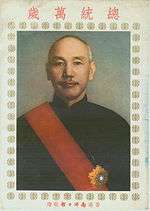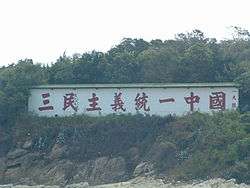Propaganda in the Republic of China

Propaganda has been an important tool of the Republic of China government since its inception in 1912. The term xuanchuan (宣傳 "propaganda; publicity") can have either a neutral connotation in official government contexts or a pejorative connotation in informal contexts.[1] Some xuanchuan collocations usually refer to "propaganda" (e.g., xuānchuánzhàn 宣传战 "propaganda war"), others to "publicity" (xuānchuán méijiè 宣傳媒介 "mass media; means of publicity"), and still others are ambiguous (xuānchuányuán 宣传员 "propagandist; publicist").[2] It also was an important tool in legitimizing the Kuomintang controlled Republic of China government that retreated from Mainland China to Taiwan in 1949.
Propaganda during the Republican Era on Mainland China, 1912–1949
Because the national government of this time was weak, it was difficult for any censorship or propagandistic measures to be carried out effectively. However, a bureau was set up to control the production and release of film in China. Also, newspapers unfavorable to the central government could be harassed at will. Following the Northern Expedition, the power of the central government increased significantly and propaganda campaigns became more effective. Propaganda of this time was directed against the Communists and the Japanese.
Propaganda of the Republic of China on Taiwan, 1949–present

One of the main tools for disseminating propaganda in Taiwan has been the Government Information Office and the various media properties controlled by the Kuomintang and the government. Besides controlling commercial TV and radio stations, there also exists a police radio station that often broadcast "educational" plays with propagandistic value and a film bureau. After the Kuomintang fled to Taiwan, propaganda through public education in Taiwan was an important tool in creating a Chinese national identity among Taiwanese, and preparing the people for "a counter-offensive" against the PRC. Although the government is now democratic, the legacy of authoritarian rule has created a confusion of identity in Taiwan, with many adults having grown up thinking that the ROC was going to launch a "counter-offensive" against the PRC and with Mandarin becoming the most common language. Previously, the people were educated in the evils of the Communists, and the good of the Nationalists, with many Taiwanese remembering lore taught in elementary school on the wisdom of Chiang Kai-shek.
The Kuomintang also published numerous publications following their retreat to Taiwan, including the Free China Journal. Its popularity soared as the editors and writers analyzed political situations at the time, sometimes even advising or criticizing the government in earnest.
Occasionally, the ROC has attempted to spread propaganda in PRC-controlled areas, usually in the form of leaflet drops over coastal provinces, calling for the locals to rebel against CPC rule, accompanied by promise that the ROC will one day liberate the mainland. This proved to be ineffective and after several years was largely discontinued.
Today, a democratic Taiwan has passed a law to abolish the Government Information Office and replace it with a National Communications Commission, styled after the FCC in the United States. The Kuomintang still controls many media properties, though its influence is much less than before. The GIO today still provides some subsidies for films, but for cultural rather than political reasons. Most films in Taiwan today are Hollywood movies and theaters are all commercially run for-profit enterprises.
Famous propaganda songs
- 'Five Flags of the Republic'
- 'How Great is Our China'
- 'National Revolutionary Song'
- 'National Banner Song'
- '800 Heroes Song'
- 'Ta-tao March'
- 'Along the Sungari River'
- 'Guerillas' Song'
- 'Marshal Training Soldier Song'
- 'Nanniwan' (Song of Communist Party in 1940s)
- 'The Plum Blossom'
- 'Chiang Kai-shek Memorial Song'
- 'Taiwan is Good'
- Go and Reclaim the Mainland
See also
| Wikimedia Commons has media related to Propaganda of the Republic of China. |